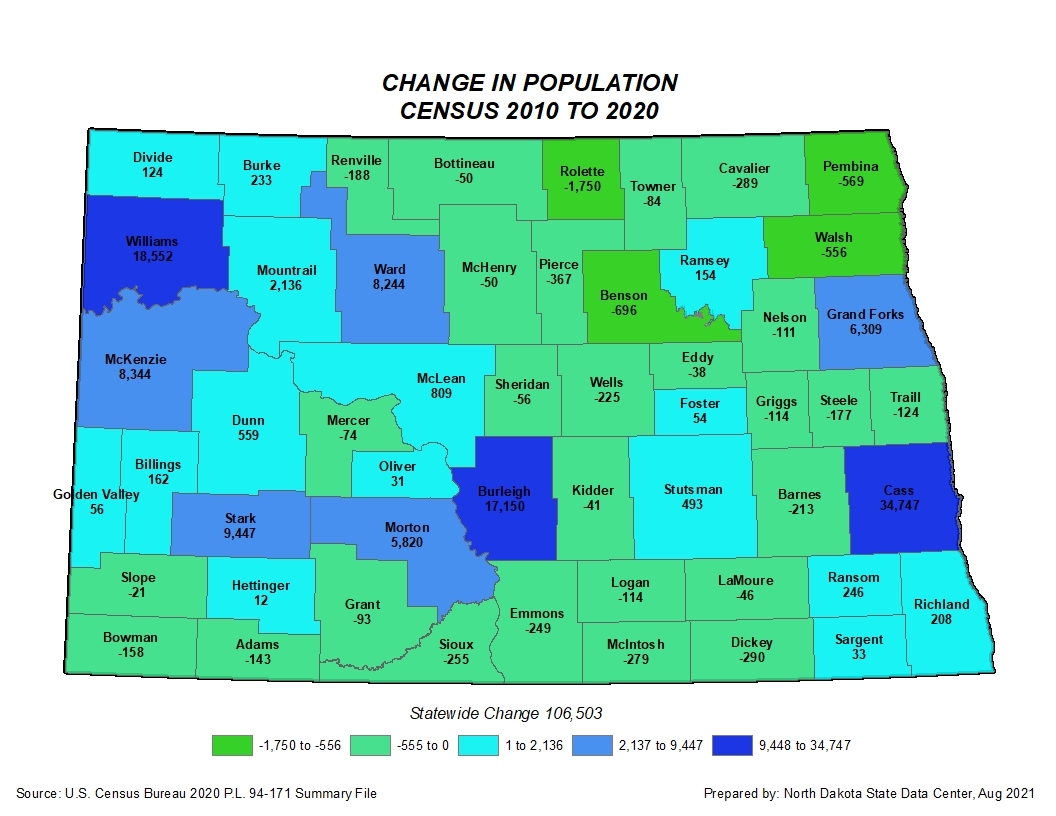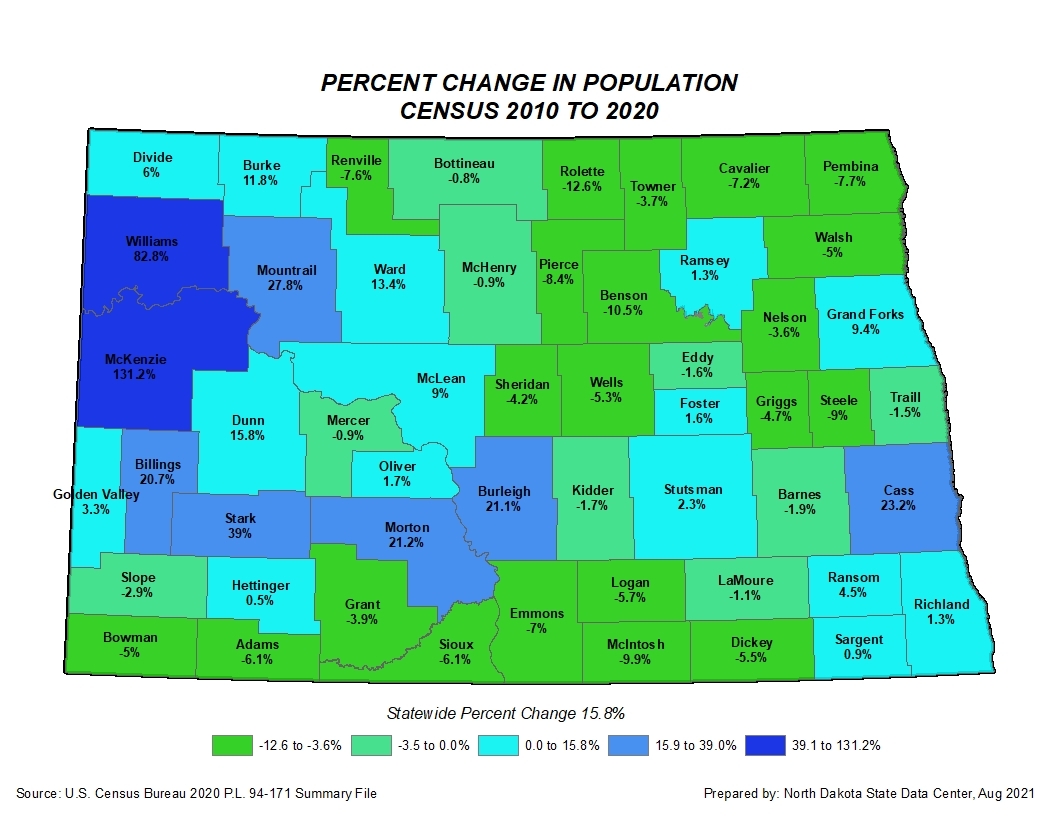So, what did we learn?
Well, a lot! The data confirms two ongoing trends that the annual population estimate process has pointed to throughout the decade, growth in the Bakken region and urbanization.
The state continues to urbanize
Early next year the Census Bureau will release the percentages of the population for each state that reside in urban areas. The expected criteria that the Census Bureau proposes is based upon housing unit density with a threshold of 385 housing units per square mile as the primary criterion for determining whether a census block is considered urban. Areas with less than 385 housing units per square mile would be considered rural.
 Overall, the western half of the state grew faster than the eastern half. The four east regions gained a net total of 36,569 while the western four regions grew by 69,810. In 2000, 56% of the state population resided in the four eastern planning regions (Devils Lake, Grand Forks, Fargo and Jamestown) with the remaining 44% in the four western regions (Williston, Minot, Dickinson and Bismarck). With the results of Census 2020, the four eastern regions share has shrunk to 52.5% compared to 47.5% for the four western regions.
Growth occurred in six of the state’s eight economic planning regions, with the largest growth in the Fargo region followed by the Williston region and then the Bismarck region. Two regions of the state lost population. The Devils Lake region lost 2,703 residents and the Jamestown region lost 734 residents.
 Only 23 of the state’s 53 counties grew, meaning the majority, 30, lost population, with only Barnes, Walsh and Rolette counties having a population of greater than 10,000, and the rest all being under 10,000 residents each.
Those that grew the most tended to be among the state’s largest counties. Cass County grew by 34,747, nearly a third of the state’s total growth since 2010 and nearly as much as the next two counties combined. Following Cass are Williams, Burleigh, Stark, McKenzie, Ward, Grand Forks and Morton in terms of the number of additional residents. When we do the math, all of the state’s increase in population can be found in adding up the sum of change in just these eight counties.
 In the Census of 1920, Cass County accounted for just 6% of the state’s population with 41,477 residents. In 2020, with 184,525 residents, it holds 24% of the state’s population, nearly one in four residents.
McKenzie County, the state’s 25th largest county in 2000, grew by 256% between that census and 2020’s. McKenzie is noted as the nation’s fastest-growing county from 2010 to 2020 with 131% growth to 14,704. In terms of its ranking, McKenzie has moved up to the state’s 10th most populous county.
 There are always surprises when this type of data is released. Rolette County was expected to have grown slightly again this past decade. The Census Bureau’s population estimate, based upon Census 2010 data, placed this county’s population at 14,165, up 228 from 2010. This did not pan out. Rolette County, the state’s 11th largest county, lost 1,750 or 13% of its population between 2010 and 2020. The county’s only previous loss over a decade was between 1950 and 1960 when it saw a loss of 461 residents. Rolette, Benson, Mountrail and Sioux, all counties with higher American Indian populations, were among the seven counties in the state where the census count came in more than 100 residents below the Census Bureau’s estimated numbers.
About the cities of the state
When you combine the Census count of all the state’s 357 cities (many of them considered to be rural areas) they held 603,660 of the state’s 779,094 residents. Seventy-seven percent of the state’s residents reside in our cities. This is up from 75% found in Census 2010 and 73% found in Census 2000. One hundred forty-six, about 41%, grew between 2010 and 2020. That means the majority of cities, 225 of the 357, actually lost population.
The larger cities tended to get larger while the smaller cities tended to get smaller. Only 10 cities saw a growth of more than 1,000 residents. More than half of the state’s population in 2000 was in just 11 cities. In Census 2020, more than half can be found in just seven cities of the state. On the other end of the scale, 137 of North Dakota’s 357 cities, or 38%, have less than 100 residents each. Nine cities had fewer than 10 residents. North Dakota’s smallest city, Ruso, declined from three residents to just one.
Fargo grew by 20,441 to 125,990 residents. The size of Fargo’s growth is larger than the resident population of all North Dakota cities except the top seven. Near Fargo, West Fargo grew the third-most by 12,796, nearly 50% growth in a decade. This is nearly the count of residents in West Fargo found in Census 2000 (14,940).
The second fastest-growing city, Williston, grew the second-most by 14,444 to 29,160, 98%, making it North Dakota’s sixth-largest city. Williston’s growth this last decade is more than the total number of residents counted in 2000.
Bismarck, Minot, Dickinson, Grand Forks also grew each by more than 5,000 residents. Bismarck gained an additional 12,350 residents, Dickinson 7,892, Minot 7,892 and Grand Forks 6,328. Percentage-wise Watford City grew by the most of any city in the state, 256%, or a total of 4,463 additional residents.
Comparing the 2020 population estimate of cities to census results
Grand Forks had the highest difference of any city between its estimated population and its census count. The Census Bureau’s estimate put the population at 55,950. The annual population estimates have tended to show a slight decline in Grand Forks’ population. Census 2020 count for the city was 73,170, a difference of 3,689 or 5.7%. Dickinson, Mandan, Minot and Jamestown also beat the estimate the Census Bureau had for these cities.
For the ranking of cities that came in below their estimate, Watford City was a bit of a surprise, with most its estimated population. Watford City was estimated to be at 7,944 but the Census 2020 count came in at 6,207, a difference of 1,737 or nearly 22%. Williston and Bismarck also came in below their estimates - Williston by 589 and Bismarck by 387.
Interestingly, while Watford City missed its estimate by 1,737, McKenzie County missed its estimate by only 538 and both Burleigh and Williams counties, in which Bismarck and Williston are located, exceeded their estimates. In the case of Burleigh County, the Census Bureau was expecting to count 96,212. Census 2020 count was 98,458, a difference of 2,246 or 2.8%. In the case of Williams County, it exceeded its estimate by 10%, the highest of any county in the state. In all three cases, it appears more individuals were residing in the more rural part of the counties than was expected.
Additional Census 2020 data is expected to be released after the beginning of the new year. A great deal will be learned about the state’s demographic makeup and how we have changed over time.
Source: Census Bureau Census 2020 Redistricting Data, files P1 through P4.
|